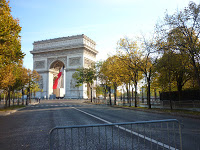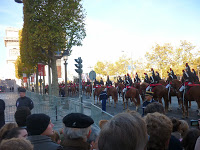Medieval History
 I've started thinking about scale a good bit lately, and Asa Mittman and Ben Tilghman's wonderful meditation on scale and sand was with me as I stood at the Armistice Day commemoration at the Arc de Triomphe yesterday. Scale seems to bring with it an awareness-otherwise-not-to-be-had (what's the word for that?) of proportions, and for me, this is very immediate around the enormous Arc de Triomphe. Commissioned by Napoleon (but finished by King Louis Philippe in 1836, long after Napoleon had stopped celebrating his victories), that muscular stretch of triumph changes radically in scale and meaning in 1920, when the Tomb of the Unknown Soldier is created beneath it. The flame that has burned without ceasing since then, already dubbed eternal in the need to know commemorations will continue, starts to stretch time and its scale and proportions around the monument as well.
I've started thinking about scale a good bit lately, and Asa Mittman and Ben Tilghman's wonderful meditation on scale and sand was with me as I stood at the Armistice Day commemoration at the Arc de Triomphe yesterday. Scale seems to bring with it an awareness-otherwise-not-to-be-had (what's the word for that?) of proportions, and for me, this is very immediate around the enormous Arc de Triomphe. Commissioned by Napoleon (but finished by King Louis Philippe in 1836, long after Napoleon had stopped celebrating his victories), that muscular stretch of triumph changes radically in scale and meaning in 1920, when the Tomb of the Unknown Soldier is created beneath it. The flame that has burned without ceasing since then, already dubbed eternal in the need to know commemorations will continue, starts to stretch time and its scale and proportions around the monument as well.
 The Arc has now stood longer over the Unknown Soldier and the commemoration of the Grande Guerre which changed war and modernity and society and bodies and everything else, than it had stood without him. These small, fragile remains, in combination with a flame that is never let out, and a solemn and grand ceremony every year has pulled the triumphalism of the Arc down to remembrance and loss and commemoration. This scale seems more human (I think I might mean more humane, too) than the celebratory proportions of Napoleonic assurances of victory. The cavalry shifted scales as well: an anachronism that somehow made the commemoration timeless, and made it stretch out across all wars - these horses held still and in formation, their energy and beauty rendering the feat beautiful.
The Arc has now stood longer over the Unknown Soldier and the commemoration of the Grande Guerre which changed war and modernity and society and bodies and everything else, than it had stood without him. These small, fragile remains, in combination with a flame that is never let out, and a solemn and grand ceremony every year has pulled the triumphalism of the Arc down to remembrance and loss and commemoration. This scale seems more human (I think I might mean more humane, too) than the celebratory proportions of Napoleonic assurances of victory. The cavalry shifted scales as well: an anachronism that somehow made the commemoration timeless, and made it stretch out across all wars - these horses held still and in formation, their energy and beauty rendering the feat beautiful.
 But it would be this little object, this "bleuet" (a wild blueberry flower or a cornflower) that would make itself known all day. We arrived at the Arc de Triomphe RER stop and all the exits save one were closed. Thus we actually got to the Champs Elysées by walking around the Arc from the back. This proved to be absolutely beautiful, as the back the Arc is still stunning but little populated. We met a woman and her son who were canvassing for Les Bleuets de France, an organization founded by two French women after WWI which raises money for veterans ("ceux qui restent") especially the wounded. In exchange for our donation we were given small, blue pins and Mac and I immediately put ours on. For the rest of the day people asked us where we had gotten our "bleuets" and for the rest of the day we harkened back to the ceremonies at the Arc de Triomphe. The little flower kept pulling us back, even as thoughts were already on Armistice Day and WWI - with Mac's scholarship so deeply involved in the War and with the incredible show that we would see later the same day at the Invalides, Vu du Front, featuring representations of WWI from soldiers in every media possible. The "bleuet" in France and the poppy in England (because of the poem, but also because of the incredible commemorative art project in the moat of the Tower of London) have become emblems for the Great War that defied all scale of loss - they are radically small and ephemeral objects that stand for (oh my goodness and with and against and have withstood) the enormity and presence of war.
But it would be this little object, this "bleuet" (a wild blueberry flower or a cornflower) that would make itself known all day. We arrived at the Arc de Triomphe RER stop and all the exits save one were closed. Thus we actually got to the Champs Elysées by walking around the Arc from the back. This proved to be absolutely beautiful, as the back the Arc is still stunning but little populated. We met a woman and her son who were canvassing for Les Bleuets de France, an organization founded by two French women after WWI which raises money for veterans ("ceux qui restent") especially the wounded. In exchange for our donation we were given small, blue pins and Mac and I immediately put ours on. For the rest of the day people asked us where we had gotten our "bleuets" and for the rest of the day we harkened back to the ceremonies at the Arc de Triomphe. The little flower kept pulling us back, even as thoughts were already on Armistice Day and WWI - with Mac's scholarship so deeply involved in the War and with the incredible show that we would see later the same day at the Invalides, Vu du Front, featuring representations of WWI from soldiers in every media possible. The "bleuet" in France and the poppy in England (because of the poem, but also because of the incredible commemorative art project in the moat of the Tower of London) have become emblems for the Great War that defied all scale of loss - they are radically small and ephemeral objects that stand for (oh my goodness and with and against and have withstood) the enormity and presence of war.
- Bonsai, And What Oliver Said
The Park Floral, near the Château de Vincennes, instantly very far away from anywhere else, worlds unto itself, is host to a disparate forest. In shallow pots of terra cotta and ceramic, on superimposed shelves, and gracing mounds are bonsai. Dozens...
- Thorough Thoreau
I would be willing to bet that Thoreau did not have children when taking his walks, especially six year olds who do not suffer pebbles in their shoes gladly. The fall colors are here, quite suddenly it seems, and so we take to the woods. But...
- Issues Of Scale
Very Cool ProjectI'm thinking through the responses of two students in my Ren-Mod survey who, when asked to comment on images (such as the one on the left) made by bacteria, made a scaled comparison between bacteria and humans. Shifts in scale...
- Cfp Redux: Thinking Small: Scale And Meaning In Medieval Art
CALL FOR PAPERS: Thinking Small: Scale and Meaning in Medieval Art Session to be held at the 2010 International Congress on Medieval Studies, Kalamazoo, Michigan, 13-16 May Sponsored by the Walters Art Museum (Baltimore, MD) Organizer: Ben C. Tilghman...
- Cfp: Thinking Small: Scale And Meaning In Medieval Art
CALL FOR PAPERS: Thinking Small: Scale and Meaning in Medieval Art Session to be held at the 2010 International Congress on Medieval Studies, Kalamazoo, Michigan, 13-16 May Sponsored by the Walters Art Museum (Baltimore, MD) Organizer: Ben C. Tilghman...
Medieval History
Of Scale and Remembrance
- Bonsai, And What Oliver Said
The Park Floral, near the Château de Vincennes, instantly very far away from anywhere else, worlds unto itself, is host to a disparate forest. In shallow pots of terra cotta and ceramic, on superimposed shelves, and gracing mounds are bonsai. Dozens...
- Thorough Thoreau
I would be willing to bet that Thoreau did not have children when taking his walks, especially six year olds who do not suffer pebbles in their shoes gladly. The fall colors are here, quite suddenly it seems, and so we take to the woods. But...
- Issues Of Scale
Very Cool ProjectI'm thinking through the responses of two students in my Ren-Mod survey who, when asked to comment on images (such as the one on the left) made by bacteria, made a scaled comparison between bacteria and humans. Shifts in scale...
- Cfp Redux: Thinking Small: Scale And Meaning In Medieval Art
CALL FOR PAPERS: Thinking Small: Scale and Meaning in Medieval Art Session to be held at the 2010 International Congress on Medieval Studies, Kalamazoo, Michigan, 13-16 May Sponsored by the Walters Art Museum (Baltimore, MD) Organizer: Ben C. Tilghman...
- Cfp: Thinking Small: Scale And Meaning In Medieval Art
CALL FOR PAPERS: Thinking Small: Scale and Meaning in Medieval Art Session to be held at the 2010 International Congress on Medieval Studies, Kalamazoo, Michigan, 13-16 May Sponsored by the Walters Art Museum (Baltimore, MD) Organizer: Ben C. Tilghman...
